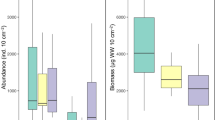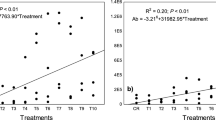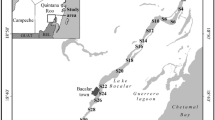Abstract
This study investigates the long-term effects of resource availability in a freshwater nematode community. We carried out a mesocosm experiment where natural nematode communities were exposed to nutrient addition/depletion over 2 years. Compared to the nutrient-addition treatment, species richness and diversity were strongly reduced upon nutrient depletion. The functional group of bacterial feeders particularly suffered severely from nutrient depletion. The decrease in diversity of bacterial feeders was linked to reduced species richness and diversity of large omnivorous species, as predicted by trophic-dynamic models. Tilman’s (1976) statement, that under low nutrient levels the best competitor dominates the system, was applicable in our system. Upon nutrient depletion, resource depletion led to a monoculture of 1 small bacterial feeder, but even after 2 years of resource depletion, up to 16 species still coexisted. Our results provide strong evidence that freshwater nematode systems can be regulated by nutrient competition.


Similar content being viewed by others
References
Aerts R, Berendse F, Caluwe A de, Schmitz M (1990) Competition in heathland along an experimental gradient of nutrient variability. Oikos 57:310–318
Arditi R, Ginzburg LR (1989) Coupling in predator prey dynamics: ratio-dependence. J Theor Biol 139:311–326
Bergtold M, Traunspurger W (2004) The benthic community in the profundal of Lake Brunnsee: seasonal and spatial patterns. Arch Hydrobiol (in press)
Danovaro R, Gambi C, Della Croce N (2002) Meiofauna hotspot in the Atacama Trench, eastern South Pacific Ocean. Deep Sea Res I 49:843–857
Fisher MM, Klug JL, Lauster G, Newton M, Triplett EW (2000) Effects of resources and trophic interactions on freshwater bacterioplankton diversity. Microb Ecol 40:125–138
Ginzburg LR, Akcakaya HR (1992) Consequences of ratio-dependent predation for steady-state properties of ecosystems. Ecology 73:1536–1543
Goss-Custard JD (1970) Responses of Redshank to spatial variations in density of their prey. J Anim Ecol 39:91–113
Hewson I, Vargo GA, Fuhrman JA (2003) Bacterial diversity in shallow oligotrophic marine benthos and overlying waters: effects of virus infection, containment, and nutrient enrichment. Microb Ecol 46:322–336
Huisman J, Weissing FJ (1999) Biodiversity of plankton by species oscillations and chaos. Nature 402:407–410
Huisman J, Weissing FJ (2000) Coexistence and resource competition. Nature 407:694
Hutchinson GE (1961) The paradox of the plankton. Am Nat 95:137–145
Kirk KL (2002) Competition in variable environments: experiments with planktonic rotifers. Freshwater Biol 47:1089–1096
Leibold MA, Chase JM, Shurin JB, Downing AL (1998) Species turnover and the regulation of trophic structure. Annu Rev Ecol Syst 28:467–494
Lotka AJ (1932) The growth of mixed populations: two species competing for a common food supply. J Wash Acad Sci 22:461–469
McQueen DJ, Post JR, Mills EL (1986) Trophic relationships in freshwater pelagic ecosystems. Can J Fish Aquat Sci 43:1571–1581
Michiels IC, Traunspurger W (2003) Maintenance of biodiversity through predation in freshwater nematodes? Nematol Monogr Perspect 2:1–15
Michiels IC, Traunspurger W (2004) A three year study of seasonal dynamics of a zoobenthos community in a eutrophic lake. Nematology (in press)
Oksanen L, Fretwell SD, Arruda J, Niemelä P (1981) Exploitation ecosystems in gradients of primary productivity. Am Nat 118:240–261
Osenberg CW, Mittelbach GG (1996) The relative importance of resource limitation and predator limitation in food chains. In: Polis G, Winemiller K (eds) Food webs. Interpretation of pattern and dynamics. Chapman and Hall, New York, pp 134–148
Parker GA, Sutherland WJ (1986) Ideal free distributions when individuals differ in competitive ability: phenotype-limited ideal free models. Anim Behav 34:1222–1242
Pfannkuche O, Thiel H (1988) Sample processing. In: Higgins RP, Thiel H (eds) Introduction to the study of meiofauna. Smithsonian Institution Press, Washington DC, pp 134–145
Pinder JE (1975) Effects of species removal on an old-field plant community. Ecology 56:747–751
Rainey PB, Buckling A, Kassen R, Travisano M (2000) The emergence and maintenance of diversity: insights from experimental bacterial populations. Trees 15:243–247
Rajaniemi TK (2002) Why does fertilization reduce plant species richness? Testing three competition-based hypotheses. J Ecol 90:316–324
Reynolds CS (1997) Vegetation processes in the pelagic: a model for ecosystem theory. Inter-Research Science, Oldendorf
Schiemer F, Löffler H, Dollfuss H (1969) The benthic communities of Neusiedler See (Austria). Verh Int Verein Limnol 17:201–208
Schmid-Araya JM (1998) Rotifers in interstitial sediments. Hydrobiologia 387/388:231–240
Silander JA, Antonovics J (1982) Analysis of interspecific interactions in a coastal plant community—a perturbation approach. Nature 298:557–560
Silver P, Palmer MA, Swan CM, Wooster D (2002) The small scale ecology of freshwater meiofauna. In: Rundle SD, Robertson AL, Schmid-Araya JM (eds) Freshwater meiofauna. Backhuys, Leiden, pp 63–104
Smale S (1976) On the differential equations of species in competition. J Math Biol 3:5–7
Smith MD, Hartnett DC, Wilson GWT (1999) Interacting influence of mycorrhizal symbiosis and competition on plant diversity in tallgrass prairie. Oecologia 121:574–582
Spackova I, Kotorova I, Leps J (1998) Sensitivity of seedling recruitment to moss, litter and dominant removal in an oligotrophic wet meadow. Folia Geobot 33:17–30
Tilman D (1976) Ecological competition between algae: experimental confirmation of resource-based competition theory. Science 192:463–465
Tilman D (1982) Resource competition and community structure. Monographs in population biology. Princeton University Press, NJ
Traunspurger W (1996) Vertical distribution of benthic nematodes in an oligotrophic lake: seasonality, species and age segregation. Hydrobiologia 331:33–42
Traunspurger W (1997) Bathymetric, seasonal and vertical distribution of the feeding-types of nematodes in an oligotrophic lake. Vie Milieu 47:1–7
Traunspurger W (2002) Nematoda. In: Rundle SD, Robertson AL, Schmid-Araya JM (eds) Freshwater meiofauna. Backhuys, Leiden, pp 63–104
Van der Meer J, Ens BJ (1997) Models of interference and their consequences for the spatial distribution of ideal and free predators. J Anim Ecol 66:846–858
Venterink HO, Wassen MJ, Verkroost AWM, de Ruiter PC (2003) Species richness-productivity patterns differ between N-, P-, and K-limited wetlands. Ecology 84:2191–2199
Volterra V (1926) Variations and fluctuations of the numbers of individuals in animal species living together (Reprinted in 1931). In: Chapman RN (ed) Animal ecology. McGraw Hill, New York
Wardle DA (2002) Communities and ecosystems: linking the aboveground and belowground components. Monographs in population biology, vol 34. Princeton University Press, NJ
Wardle DA, Bonner KI, Barker GM, Yeates GM, Nicholson KS, Bardgett RD, Watson RN, Ghani A (1999) Plant removals in perennial grassland: vegetation dynamics, decomposers, soil biodiversity, and ecosystem properties. Ecol Monogr 69:535–568
Wilson SD, Tilman D (1991) Components of plant competition along an experimental gradient of nitrogen availability. Ecology 72:1050–1065
Yeates GW, Bongers T, De Goede RGM, Freckman DW, Georgieva SS (1993) Feeding habits in soil nematode families and genera—an outline for soil ecologists. J Nematol 25:315–331
Zamfir M, Goldberg DE (2000) The effect of initial density on interactions between bryophytes at individual and community levels. J Ecol 88:243–255
Acknowledgements
Many thanks go to Matthias Bergtold, Helmut Hillebrand, Hubert Spieth, Fritz Trillmich and two anonymous reviewers for helpful comments on earlier versions of the manuscript. The study was supported by the German National Merit Foundation.
Author information
Authors and Affiliations
Corresponding author
Rights and permissions
About this article
Cite this article
Michiels, I.C., Traunspurger, W. Impact of resource availability on species composition and diversity in freshwater nematodes. Oecologia 142, 98–103 (2005). https://doi.org/10.1007/s00442-004-1700-6
Received:
Accepted:
Published:
Issue Date:
DOI: https://doi.org/10.1007/s00442-004-1700-6




